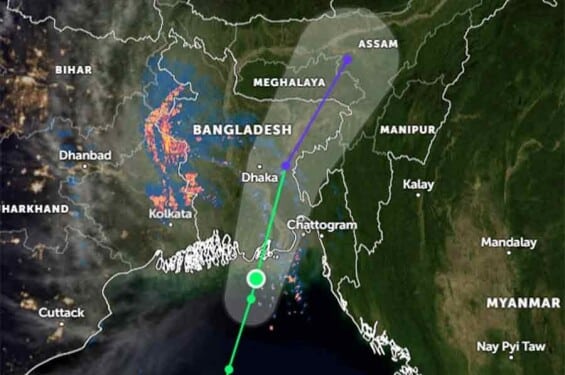Cyclone Sitrang weakens into depression

Cyclonic Sitrang crossed the Barishal-Chattogram coast near Bhola around midnight on Monday but weakened rapidly into a depression by giving precipitation, the weather department said in its latest bulletin on Tuesday., Report UNB.
Sitrang moved north-northeastwards very fast and crossed the Barishal-Chattogram coast, and now lies over DhakaCumilla-Brahmanbaria and adjoining areas as a land depression, according to the Bangladesh Meteorological Department (BMD). T
he maritime ports of Mongla, Payra, and Chattogram have been advised to lower danger signal number 7 and hoist local cautionary signal number 3 instead.
Meanwhile, the maritime port of Cox’s Bazar has been advised to lower danger signal number 6 and hoist local cautionary signal number 3.
Under the influence of the new moon phase and steep pressure gradient, the low-lying areas of the coastal districts of Satkhira, Khulna, Bagerhat, Jhalokathi, Pirojpur, Barguna, Patuakhali, Bhola, Barishal, Laxmipur, Chandpur, noakhali, Feni, Chattogram, Cox’s Bazar and their offshore islands and chars are likely to be inundated by the wind-driven surge height of 3-5 feet above the normal astronomical tide.
All fishing boats and trawlers over the north Bay and deep sea have been advised to remain in shelter until further notice. The front part of the cyclone started lashing Bangladesh from Monday evening, while its centre made its landfall in the early hours of Tuesday.
The maximum sustained wind speed within 54 kilometres of the cyclone’s centre at that point was about 62 kilometres per hour rising to 88 kilometres per hour in gusts or squalls.
As Sitrang started lashing the country’s coastal areas, nearly all of Bangladesh suffered under inclement weather with uprooted trees or falling branches killing people and disconnecting power transmission lines, and incessant rainfall causing waterlogging in urban areas.
Authorities scrambled to move at risk populations to the nearest of some 7,000 cyclone shelters that were opened up, mostly in the 19 coastal districts.
According to reports coming in late on Monday night, over 2 lakh people were evacuated to these shelters by the time of Sitrang’s landfall. Authorities in the three southern divisions, meanwhile, declared the closure of all educational institutions till further notice, with some of their premises pressed into operation as cyclone shelters.
Most parts of the country, including Dhaka, witnessed moderate to heavy rains throughout Monday under the impact of the cyclonic storm.
Authorities prepared more than 7,000 cyclone shelters to evacuate people, while all fishing boats and trawlers over the north Bay and deep sea have been asked to remain anchored.
Authorities in Chattogram and other hilly districts warned that landslides could occur if continuous downpour continued.
UNB correspondents from across the southern coastal region reported heavy rains and tidal surges since Monday morning.
Meanwhile, many areas in capital Dhaka and neighbouring Narayanganj plunged into darkness, following a huge disruption in power supply that authorities blamed on Cyclone Sitrang.
According to officials of the Dhaka Power Distribution Company Limited (DPDC) and Desco, the two entities which control the distribution network in Dhaka and Narayanganj, many areas experienced blackouts for hours following a fault in the Sympur, Ulan and Maniknagar grid line.
“Due to the grid disruption, power supply went off in Dhanmondi, Sher-e-Banglanagar, Kakrail, and Kajla in Dhaka city and also in some areas in Narayanganj city,” Bikash Dewan, managing director of DPDC, told UNB.
He said many areas also experienced blackouts due to the collapse of trees on the power distribution lines due to the cyclone.





